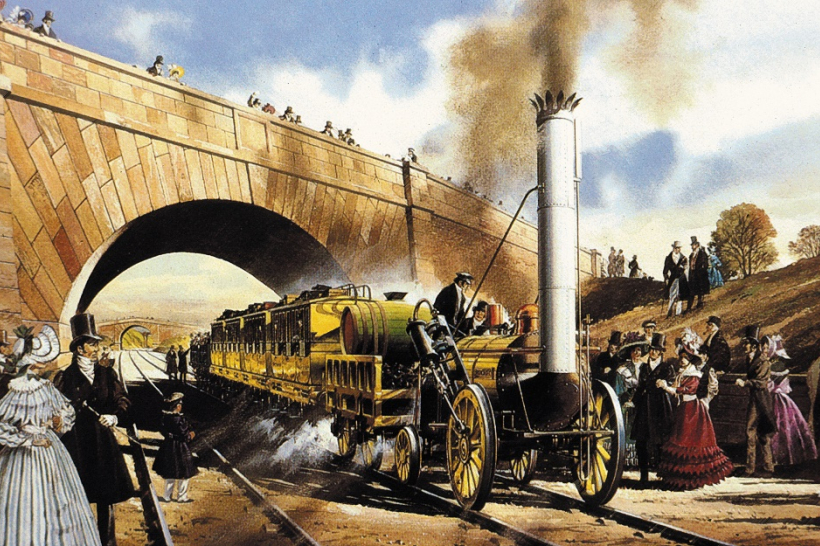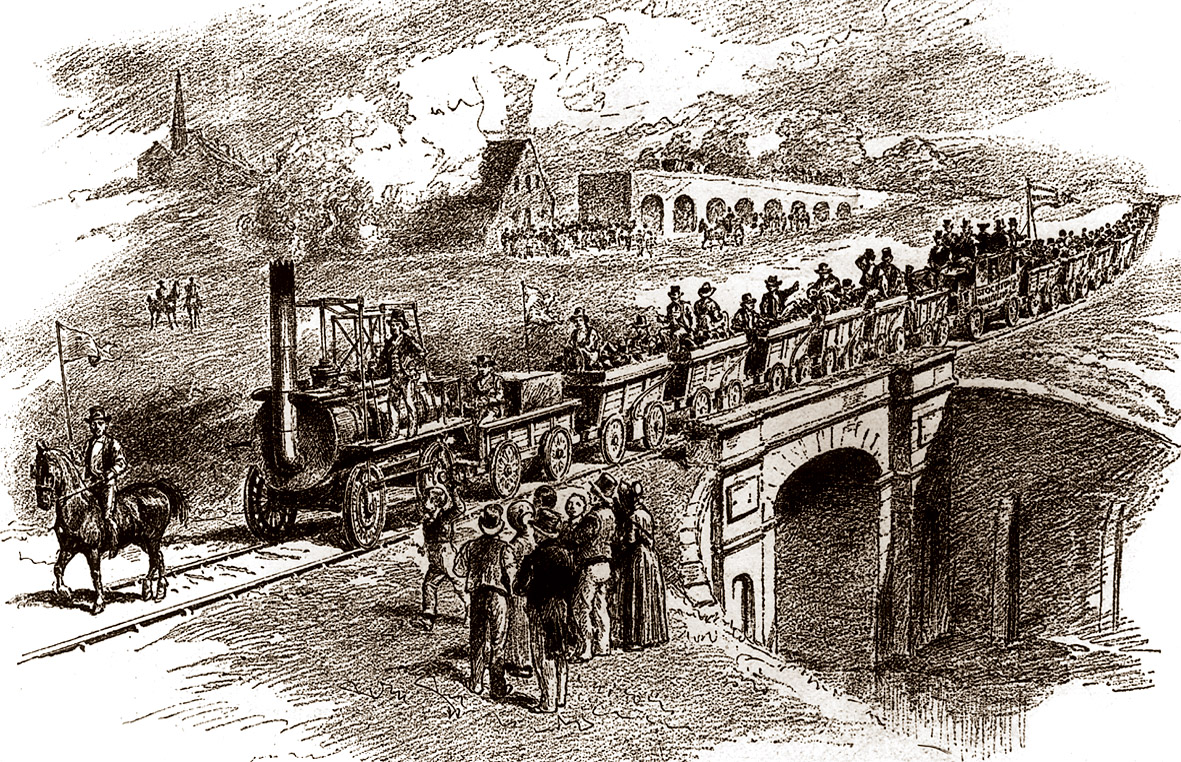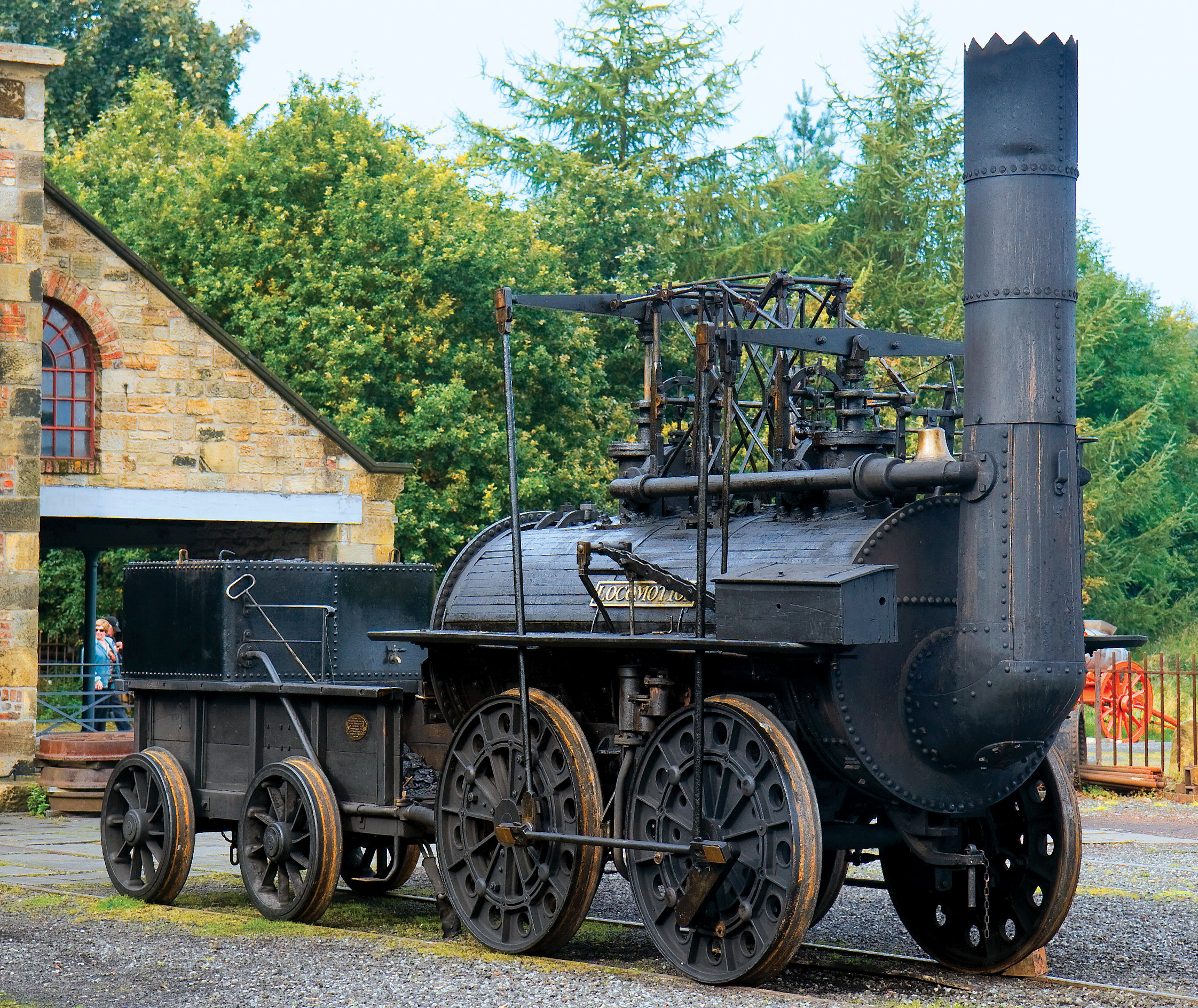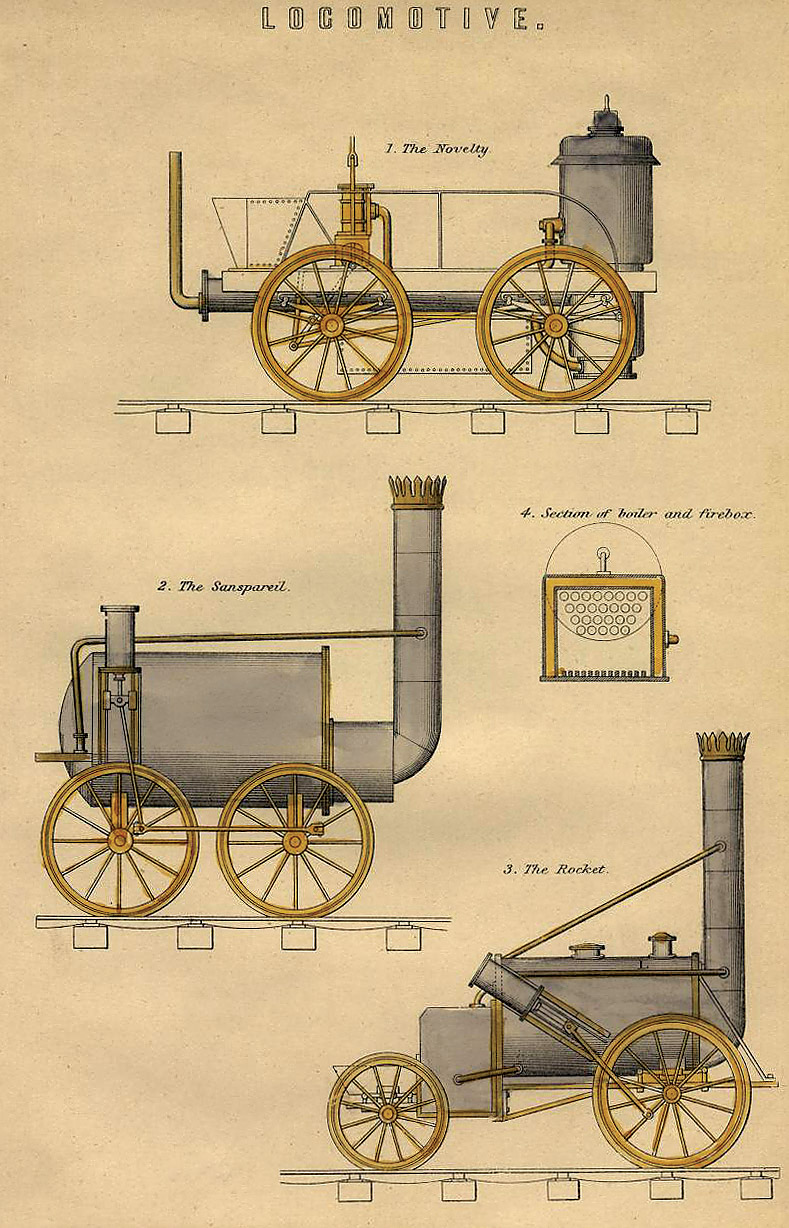
Ilustracja upamiętniająca konkurs w Rainhill i przejazd parowozu "Rakieta"
Historia kolei
29 stycznia 2021

Ilustracja upamiętniająca konkurs w Rainhill i przejazd parowozu "Rakieta"
Konie w parze z lokomotywami
Z powodu wysokich kosztów transportu węgla z zagłębia w Durham do Stockton nad Tess, właściciele miejscowych kopalń stanęli przed widmem bankructwa. W 1821 roku utworzyli więc towarzystwo, którego celem miała być budowa kolei konnej do Stockton. Kierownikiem przedsięwzięcia został George Stephenson - maszynomistrz kopalń węgla oraz entuzjasta i pionier kolejnictwa. Oprócz klasycznej trakcji konnej, Stephenson miał zastosować również lokomotywy parowe. W celu zapewnienia dostaw dla nowej linii, w 1824 roku, Stephenson zbudował w Newcastle pierwszą na świecie fabrykę parowozów.
Locomotion znaczy parowóz
Kolejny przełom nastąpił we wrześniu 1825 roku, kiedy to Stephenson skończył budowę pierwszego parowozu dla nowej kolei. Pierwotnie nazwał go „Active” (ożywiony energią), lecz wkrótce zmienił nazwę na „Locomotion”. 27 września 1825 roku uroczyście otwarto, mierzącą 19 kilometrów, linię kolejową ze Stockton do Darlington. Data ta została uznana za symboliczny dzień narodzin kolei. Wtedy to, po raz pierwszy w składzie pociągu znalazł się wagon pasażerski „Experiment”, którym podróżowali zaproszeni notable. Prowadzony przez Stephensona parowóz „Locomotion”, ciągnąc 80 ton ładunku węgla i mąki, pokonał trasę w ciągu 65 minut, osiągając na jednym z odcinków prędkość 39 km/h.

Historyczny przejazd parowozu "Locomotion" na trasie Stockton-Darlington - 27 września 1825 r.
Najlepsze torowiska? – poziome
Kiedy budowano kolej ze Stockton do Darlington, Stephenson zauważył, że nawet niewielkie wzniesienia terenu znacznie zmniejszały prędkość parowozu, a małe jego spadki powodowały, że prymitywne hamulce stawały się bezużyteczne. Doszedł więc do wniosku, że tory powinny być układane na jak najbardziej poziomym podłożu. Wykorzystał tę wiedzę podczas pracy nad koleją Bolton-Leigh. W celu wyrównania trasy pociągu, zlecił wówczas zrobienie serii trudnych wykopów, nasypów i wiaduktów kamiennych.
Sukces Stephensona skłonił przedsiębiorców do budowy podobnej linii z Manchesteru do Liverpoolu. W pierwszym z tych miast sprawnie rozwijał się przemysł włókienniczy i górniczy, a obrót towarowy z portem w Liverpoolu przekraczał 1000 ton dziennie. Tymczasem towary przewożono w sposób tradycyjny, co sprawiało, że transport bawełny zza oceanu trwał krócej, niż przewiezienie jej z Liverpoolu do Manchesteru odległego o 56 kilometrów.
Kampania antykolejowa
Dowiedziawszy się o projekcie budowy kolei, właściciele konnych i rzecznych przedsiębiorstw transportowych rozpętali, na szeroką skalę, kampanię antykolejową, angażując w nią prasę. Sprawa stała się tematem wielu burzliwych dyskusji w parlamencie angielskim. Rozpowszechniano rozmaite, wręcz absurdalne plotki, w tym i takie, że sapiący i dymiący wehikuł wystraszy zwierzęta domowe (krowy stracą mleko, kury nie będą znosić jaj), w lasach wyginie zwierzyna, wzrośnie liczba poronień u kobiet, dym z lokomotywy tak przesłoni niebo, że nawet w dzień będzie ciemno, domom i lasom zagrozi pożar, a w przypadku wykolejenia się parowozu, nastąpi potężny wybuch kotła, który uśmierci tysiące ludzi i zmiecie z powierzchni ziemi okoliczne zabudowania. Dlatego, gdy w 1826 roku, w parlamencie, z wielkim trudem forsowano projekt budowy linii kolejowej Manchester-Liverpool, mieszkańcy terenów, przez które miał przejeżdżać pociąg, wpadli w panikę. Odnotowano nawet groźne rozruchy, zdarzało się także, że przysłani do pracy robotnicy musieli salwować się ucieczką przed atakującymi ich mieszkańcami.
Nową linię obsłuży najlepszy
Wobec licznych wątpliwości, zdecydowano się na ogłoszenie konkursu na najlepszy parowóz, który miałby obsługiwać nową linię. Test praktyczny zorganizowano w Rainhill, gdzie przygotowany został specjalny tor o długości 2,8 kilometra. Każda z lokomotyw miała przejechać dziesięciokrotnie przed widzami, zgromadzonymi na trybunach. Oceny technicznej oraz kontroli czasu przejazdu dokonywała komisja, w której skład weszli: John Kennedy, John Rastrick i Nicholas Wood – ówcześni znakomici znawcy kolejnictwa. Członkowie komisji mieli zadecydować o tym, komu przypadnie nagroda w wysokości 500 funtów szterlingów. Jednak, to nie nagroda była najważniejsza dla uczestników konkursu. Zwycięzca miał zostać producentem i dostawcą parowozów dla nowo budowanej linii kolejowej.
W konkursie w Rainhill mogły wziąć udział wyłącznie maszyny, spełniające następujące wymagania:
• same wytwarzały parę
• ważyły nie więcej niż 6,1 tony
• ciśnienie w kotle nie przekraczało 3,5 atmosfery
• ciągnęły na wyznaczonym odcinku 20-tonowy pociąg z prędkością co najmniej 16 km/h
• miały nie więcej niż sześć kół
• wysokość komina nie przekraczała 4,5 metra
• koszt budowy parowozu nie mógł być wyższy niż 550 funtów szterlingów.
Ostatecznie w dniu konkursu, 6 października 1829 roku, na starcie stanęło pięć lokomotyw:
„Cyklop” („The Cycloped”) Thomasa Shaw Brandretha
„Niezrównana” („The Sans Pareil”) Timothy’ego Hackwortha
„Nowina” („The Novelty”) Johna Braithwaita i Johna Ericssona
„Rakieta” („The Rocket”) George’a Stephensona
„Wytrwałość” („The Perseverance”) Timothy’ego Burstalla.

"Locomotion" George'a Stephensona - jedna z najsłynniejszych lokomotyw parowych
O nierównej rywalizacji czyli… o koniu wewnątrz parowozu
Już podczas oględzin jury zdyskwalifikowało dwa parowozy. Okazało się bowiem, że wewnątrz trzytonowego „Cyklopa” umieszczono żywego konia! Natomiast „Wytrwałość” zużywała za dużo węgla i nie spełniała warunków rywalizacji (konstruktorowi przyznano 25 funtów szterlingów nagrody pocieszenia). Parowóz „Niezrównana” prawie ukończył próby, choć pojawiła się wątpliwość, czy dozwolone jest, by mógł współzawodniczyć przy ciężarze własnym przekraczającym o 300 funtów (136 kg) dozwolony limit. Niemniej jednak przejechał osiem kursów, zanim roztrzaskał się cylinder. Po tym poważnym uszkodzeniu konstruktor nie zdołał już uruchomić maszyny w krótkim czasie. Pomimo niepowodzenia, parowóz Hackwortha został kupiony przez kolej Liverpool-Manchester, gdzie jeździł przez dwa lata, zanim wypożyczono go kolei Bolton-Leigh.
Ostatnią maszyną, która odpadła z konkursu, była „Nowina”, zbyt nowatorska jak na 1829 rok, lżejsza i znacznie szybsza, niż inne konkurujące lokomotywy. Była niewątpliwie ulubienicą widzów. Niestety, po osiągnięciu w pierwszym dniu zawodów, zaskakującej jak na owe czasy prędkości 45 km/h, w kotle doszło do uszkodzenia rury, której nie zdołano naprawić na miejscu w krótkim czasie. „Nowina” kontynuowała próby następnego dnia, osiągając zaledwie 24 km/h. Ponownie uległa awarii i została wykluczona z rywalizacji.

Trzy lokomotywy biorące udział w zmaganiach w Rainhill: "Nowina" , "Niezrównana" oraz zwycięska "Rakieta"
Zwycięzca – „Rakieta” Stephensona
Jedynym parowozem, który oparł się przeciwnościom, była „Rakieta”. Stephenson doczepił do niej wagon z 30 pasażerami i przejechał wyznaczoną trasę, osiągając prędkość 45 km/h. Podczas każdej próby rywalki „Rakiety” zawodziły. Stephenson otrzymał 500 funtów szterlingów oraz kontrakt na produkcję lokomotyw dla kolei Liverpool-Manchester.
Zarówno George Stephenson, jak i jego syn Robert byli obdarzeni szóstym zmysłem i nadzwyczajnymi umiejętnościami w zakresie wprowadzania nowości. Większość innowacji technicznych w parowozie „Rakieta” została jedynie adaptowana. Przykładem może być chociażby użycie kotła płomieniówkowego z paleniskiem otoczonym wodą, co umożliwiło „Rakiecie” zwycięstwo w konkursie w Rainhill. Ten przełomowy wynalazek został opatentowany w lutym 1828 roku przez Marca Séguina we Francji. W Wielkiej Brytanii, niezależnie od francuskiego odkrywcy skonstruował go Henry Booth, sekretarz towarzystwa kolejowego Liverpool and Manchester Railway.

Ilustracja upamiętniająca konkurs w Rainhill i przejazd parowozów "Niezrównana" i "Nowina"
Parowóz – nowy hit w transporcie
Konkurs, choć tylko częściowo udany, dowiódł jednak, że parowozy mogą bezpiecznie kursować z prędkością nieosiągalną dla trakcji konnej. Zmieniło to opinię zarówno o tych maszynach, jak i o całej kolei. W ślad za tym wydarzeniem, inicjatywy budowy nowych linii kolejowych były życzliwie przyjmowane przez władze i mieszkańców. Na trasie Liverpool-Manchester, dla której zorganizowano konkurs, nigdy nie wprowadzono trakcji konnej. 14 czerwca 1830 roku pociąg próbny z lokomotywą o nazwie „Arrow” („Strzała”) przebył ją zaledwie w półtorej godziny. Tak rozpoczęły się dzieje prawdziwej kolei, obsługującej ruch towarowy i pasażerski. Wynik konkursu dał odpowiedź na pojawiające się wcześniej pytanie: czy jako środka lokomocji należy używać parowozów, czy może zwierzęcej siły pociągowej?